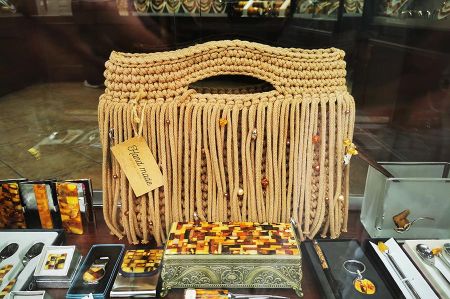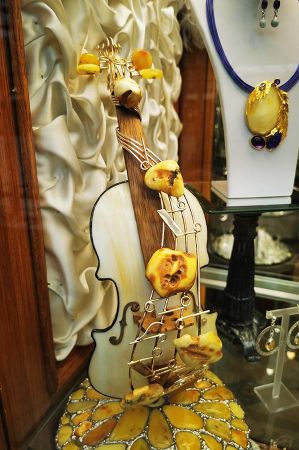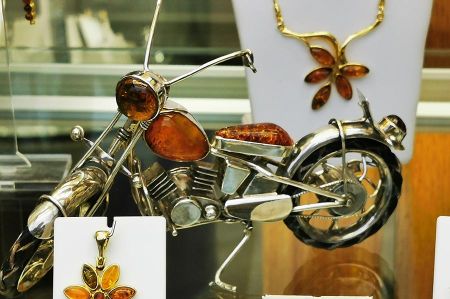Danziger Goldwasser and other abnormalities
- Written by Portal Editor
A family celebration took us to Gedingen again, so it was clear that we were finally able to add two more days to this visit to Poland and were able to plan a trip to the old Hanseatic city of Danzig and a collecting center for amber back in Roman times.
So first there was a tour of the magnificent courtyard gardens (a report will follow), then we were supposed to go to the old town for coffee and cake, which was to be followed by a first tour along the amber jewelry shops (starting point of the Roman Amber Route?).
Apple tart with vanilla ice cream - simply delicious
 Not that we had anything extraordinary planned in the café we happened to go to, but then we were surprised by the cake we ordered: a construction of apple tart with vanilla ice cream, with rings of dried orange and lime in between, a delicious sauce and the whole thing very attractively decorated: a dream and so delicious!
Not that we had anything extraordinary planned in the café we happened to go to, but then we were surprised by the cake we ordered: a construction of apple tart with vanilla ice cream, with rings of dried orange and lime in between, a delicious sauce and the whole thing very attractively decorated: a dream and so delicious!
And while we were on the subject of enjoyment, a little later there was a shop that displayed Danziger Goldwasser in its displays, a drink that I know well from my grandmother's lifetime, because there was a sip every evening. Danziger Goldwasser is a spiced liqueur that was originally produced by the liqueur factory “Der Lachs zu Danzig”. Its history can be traced back to the 16th century, not that my grandmother was that old but she had spent a few years in Gdansk. The clear and spicy-sweet liqueur, in which small gold leaf flakes float, has an alcohol content of 40 percent by volume and popular opinion says that it has various health-boosting effects, whether just truth or pure mythology. Helped my grandma live to old age.
On the history of Danziger Goldwasser
 The Dutch immigrant Ambrosius Vermöllen, a religious Mennonite of the 16th century who fled from Lier, founded the factory in the Danzig house “Der Lachs” in 1598, produced liqueurs under the same name and sold them initially locally and then even internationally. Due to the technical development of distillation, the production of alcoholic beverages based on herbs and spices increased in the 17th century. Occasionally, gold and silver leaves were also added to these alcoholic beverages - possibly to enhance the healing effects of the herbal extracts (according to the views of alchemical medicine, which was very widespread at the time), but perhaps also to demonstrate wealth. Gold as a medicinal ingredient can be found in the aurum potabile (drinkable gold, gold tincture, güldenwasser), which was offered from the Middle Ages to modern times and consisted of thinly hammered gold plates soaked in vinegar, vegetable oil or (alcoholic) aqua vitae and was generally considered an elixir of life. In the Middle Ages, the elixir aqua auri (golden water) was already available as a medicine that was originally gold-colored or valuable in gold and only later contained gold.
The Dutch immigrant Ambrosius Vermöllen, a religious Mennonite of the 16th century who fled from Lier, founded the factory in the Danzig house “Der Lachs” in 1598, produced liqueurs under the same name and sold them initially locally and then even internationally. Due to the technical development of distillation, the production of alcoholic beverages based on herbs and spices increased in the 17th century. Occasionally, gold and silver leaves were also added to these alcoholic beverages - possibly to enhance the healing effects of the herbal extracts (according to the views of alchemical medicine, which was very widespread at the time), but perhaps also to demonstrate wealth. Gold as a medicinal ingredient can be found in the aurum potabile (drinkable gold, gold tincture, güldenwasser), which was offered from the Middle Ages to modern times and consisted of thinly hammered gold plates soaked in vinegar, vegetable oil or (alcoholic) aqua vitae and was generally considered an elixir of life. In the Middle Ages, the elixir aqua auri (golden water) was already available as a medicine that was originally gold-colored or valuable in gold and only later contained gold. Another theory about the creation of Goldwasser goes back to the technique of gilding, for which specialized artisans in Gdańsk are said to have been famous. In principle, the gilding of furniture, mirrors or picture frames is done by applying extremely thin gold foil. This is done with the help of brushes of different widths and different hardnesses that are adapted to the surfaces. The gilder has to pick up the extremely thin gold foil and apply it to the wood - to do this, he dips the brush in alcohol, first coats a spot in the wood with it and then dips the brush into the alcohol again: This means that the adhesion allows him to easily attach the foil Let the brush stick and apply. The gilder presses the foil firmly onto the wood.
Another theory about the creation of Goldwasser goes back to the technique of gilding, for which specialized artisans in Gdańsk are said to have been famous. In principle, the gilding of furniture, mirrors or picture frames is done by applying extremely thin gold foil. This is done with the help of brushes of different widths and different hardnesses that are adapted to the surfaces. The gilder has to pick up the extremely thin gold foil and apply it to the wood - to do this, he dips the brush in alcohol, first coats a spot in the wood with it and then dips the brush into the alcohol again: This means that the adhesion allows him to easily attach the foil Let the brush stick and apply. The gilder presses the foil firmly onto the wood.
The alcohol ensures that the wood has an adhesive effect for the short remaining working time, but then diffuses through the remaining wood pores, meaning that the piece of furniture or frame does not “sweat” under the gold. The alcohol used is replaced after a while because it is contaminated with the finest wood dust and dirt and can therefore prevent a smooth gold surface. Because the gilders repeatedly left pieces of gold from the brush in the alcohol when they dipped the brushes again, the glittering liquid was created, which is said to have only been diluted to drinking strength and made tasty with the addition of spices.
Such “Güldenwasser” with real 22-carat gold leaf became a noble social drink. Danziger Goldwasser became Catherine the Great's and my grandma's favorite liqueur. During the Second World War, the house “Der Lachs” and the spirits factory where Goldwasser was produced were destroyed. After the end of the war, the production of Goldwasser was resumed according to the old recipe in the Berlin branch of the liqueur factory; the recipe was later passed on to Hardenberg-Wilthen AG in Nörten-Hardenberg, which still sells Danziger Goldwasser throughout Europe.
During the Second World War, the house “Der Lachs” and the spirits factory where Goldwasser was produced were destroyed. After the end of the war, the production of Goldwasser was resumed according to the old recipe in the Berlin branch of the liqueur factory; the recipe was later passed on to Hardenberg-Wilthen AG in Nörten-Hardenberg, which still sells Danziger Goldwasser throughout Europe.
The liqueur was also continued to be produced in Poland by the Polmos company in Starogard Gdański; later production was moved to Poznań. Production of the liqueur stopped there in June 2009, although the rights to the brand were retained.
The Danziger Goldwasser can be traced back to the story presented above, which, among other things, Contains distillates of cardamom, coriander, lemon and bitter orange peels, juniper berries, caraway, lavender, cinnamon, celery fruits and mace, a strange-seeming composition but still interesting in terms of taste.
Along the canal with its amber shops
 There were so many new insights into the origins of Grandma's Danziger Goldwasser and the various creative ideas for using amber. Clearly, the use of amber as jewelry in every conceivable shape and design is available for purchase here in a huge range.
There were so many new insights into the origins of Grandma's Danziger Goldwasser and the various creative ideas for using amber. Clearly, the use of amber as jewelry in every conceivable shape and design is available for purchase here in a huge range.
It is also clear that the ancient Romans already loved amber and transported it in large quantities along the so-called Amber Route to Aquileia on the Mediterranean, where it was then further distributed throughout the Roman Empire.
 The exported amber also brought Roman trade goods back to Danzig. Trade, which, in addition to stress and disputes, also brought people and cultures closer together, started over 2,000 years ago.
The exported amber also brought Roman trade goods back to Danzig. Trade, which, in addition to stress and disputes, also brought people and cultures closer together, started over 2,000 years ago.
We find interesting design and use of amber and at this point we will only mention two examples that we particularly liked (of course due to our affinity for music and motorcycling). The creativity and inventiveness of the manufacturers alone is admirable, right?
Please also read:
Kalkriese in the Osnabrück region - scene of the Varus battle?
Mucem - Filigree latticework made of ultra-high-performance concrete
